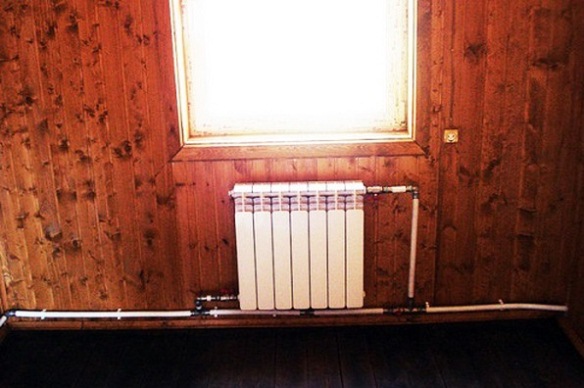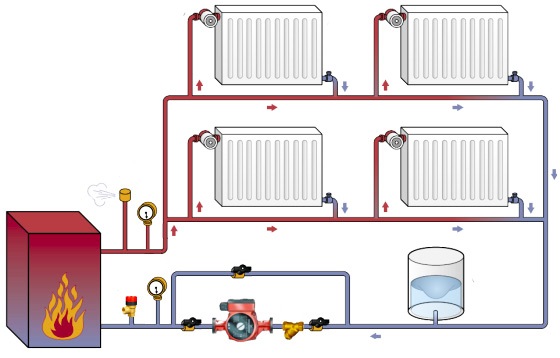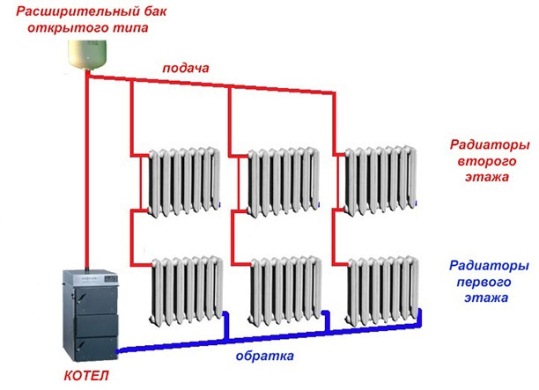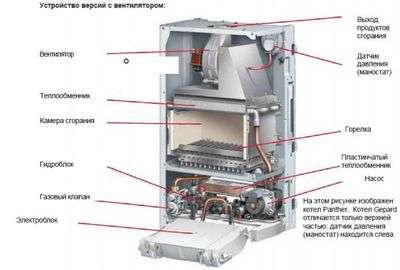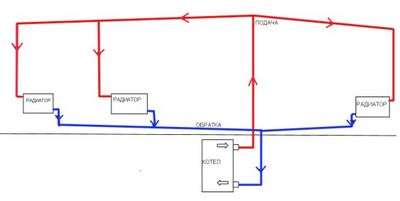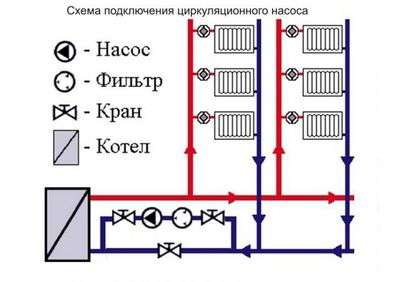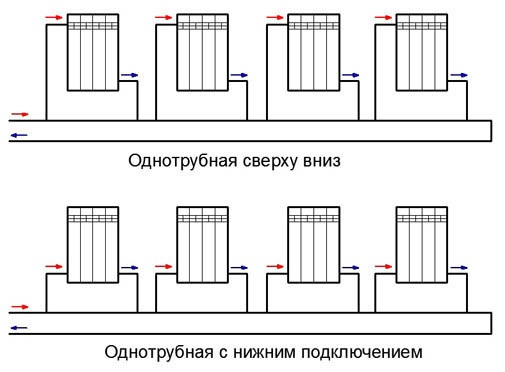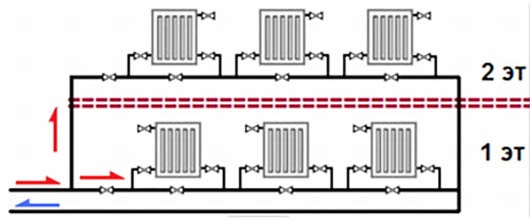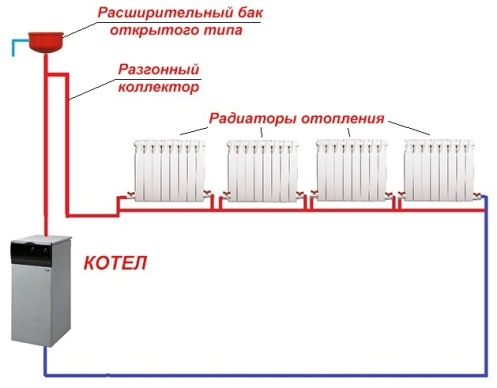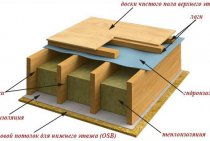Some installation features
Using information from the Internet when designing a system and doing your own installation, remember that a large amount of material read and watched video increases your chances of successfully completing what you started. But the best way to organize heating with your own hands would be to attract, at a minimum, a professional practitioner for consulting support.
To ensure high-quality heating of the extreme radiators in the chain, the number of their sections should be increased.
For the gravity version of the system, pipes of significant diameter are necessarily used. And the total length of the circuit should not exceed 30 m.
The installation of the supply main pipe must be carried out at a slight slope. The radiators themselves are installed at the same height and do not distort the “geometry” of the room at all.
The vertical wiring of the "Leningrad" and the long "horizontal" will definitely require the introduction of a circulation pump into the system.
When installing a supply pipe in the thickness of the floor with your own hands, you should remember about the need to insulate it with heat-insulating roll materials. This will save you significant money during the operation of the system and will not lead to overheating of the "underground" space.
Photo of a needle type crane
ball valve
Only needle-type valves should be used as shut-off valves on bypasses and auxiliary circuits of the system. They are able to smoothly regulate the flow of fluid through themselves. The use of ball valves is not allowed here, as they are not designed for "semi-open" operation. They are either closed or completely open. Only in these two positions is their long-term performance preserved. There are enough videos on the net on this subject.
Finishing a long stream of thoughts, we want to note that the single-pipe “Leningradka”, which has long been proven for decades of use, with a modern “upgrade” with a circulation pump and control valves on bypasses, allows you to get the benefits of a more complex heating system with its real simplicity and low investment. Ensure its proper installation with your own hands and spend the cold seasons in the warmth and comfort of your private home.
Pros and cons of the Leningradka heating scheme
The main advantages provided by the heating system "Leningradka" in the organization of water heating of the premises are: high efficiency, simple installation and maintenance. But unfortunately, such single-pipe heating systems are not without drawbacks:
- the heating batteries most distant from the boiler in the serial pipeline circuit should have the maximum number of sections, since the water reaching them through the pipe will be cooled;
- the Leningradka heating system does not provide for connecting a heated floor or a heated towel rail;
- the coolant circulates through the circuit at a sufficiently high pressure.
But such shortcomings are inherent in the traditional single-pipe heating scheme, which does not use elements for regulating the supply of coolant to radiators. Therefore, installing a bypass with a needle valve on each battery allows you to manually set the temperature of each individual radiator. This made it possible to achieve flexibility and cost-effectiveness in adjusting the water heating system.
The improved and modified Leningradka heating system is considered an excellent choice for heating various kinds of premises. Therefore, its use will help to create a simple and at the same time effective and inexpensive heating of both a country cottage and a city apartment or a private house.
Pros and cons
The main advantages of the scheme, because of which the "Leningrad" is so popular, are:
- low cost of materials;
- ease of installation.
Another thing is when metal-plastic or polyethylene pipes are used for installation. Remember that the Leningrad wiring diagram provides for a large diameter supply line, while in a two-pipe system the pipe size will be smaller. Accordingly, fittings of a larger diameter are used, which means that they will cost more and, in general, the cost of work and materials will be higher.
As for ease of installation, the statement is absolutely true. A person who is at least a little versed in the issue will calmly assemble the Leningradka scheme. The difficulty lies elsewhere: before installation, a careful calculation of pipelines and radiator power is required, taking into account the significant cooling of the coolant. If this is not done and the system is assembled at random, then the result will be sad - only the first 3 batteries will heat, the rest will remain cold.
In fact, the virtues for which the "Leningradka" is so valued are very illusory. It is easy to install, but difficult to design. It can boast of cheapness only if it is assembled from certain materials, and they do not suit everyone.
An important drawback of the Leningrad scheme stems from its principle of operation and lies in the fact that it is very problematic to regulate the heat transfer of batteries using thermostatic valves. The figure below shows the Leningrad heating system in a two-story house, where such valves are installed on batteries:
This scheme will function all the time separately. As soon as the first radiator heats the room to the set temperature, and the valve shuts off the coolant supply, its bulk will rush to the second battery, the thermostat of which will also start to work. And so on until the very last device. When cooled, the process will repeat itself, only in reverse. When everything is calculated correctly, the system will heat more or less evenly, if not, the last batteries will never heat up.
In the Leningrad scheme, the operation of all batteries is interconnected, so it makes no sense to install thermal heads, it is easier to balance the system manually.
And the last. "Leningradka" functions quite reliably with forced circulation of the coolant, and it was conceived as part of a centralized heat supply network. When a non-volatile heating system without a pump is needed, then Leningradka is not the best option. To get good heat transfer with natural circulation, you need a two-pipe system or a vertical single-pipe system, shown in the figure:
water circulation
How does the heating boiler and all other elements of the system work? The movement of fluid along closed circuits can be natural or forced. The water that is heated by the heating boiler goes into the batteries. This part of the circuit is a forward stroke or forward current. When the coolant enters the batteries, it cools down and then goes back to the heating boiler for heating. This is reverse or reverse current. In order to speed up the circulation of the coolant, special devices are used - circulation pumps that cut into the pipeline at reverse current.
Gas boiler device with built-in circulation pump
It is worth noting that at present one can find such models of boilers, the design of which provides for the presence of such a pump.
Consider such a heating boiler scheme, which provides for the natural circulation of the coolant - for example, water flows by gravity. This can be done due to the fact that a physical effect occurs, which manifests itself when the density of water changes. After all, hot water has a lower density. The liquid that goes back already has a high density, so it easily displaces the water that has already warmed up.Hot water goes up the riser, then it is distributed through horizontal pipes, which are laid at a slope of 3-5 degrees. It is due to the slope that the liquid moves by gravity.
Heating system with natural circulation
The connection scheme for a heating boiler with natural circulation is the simplest scheme, which is why it is easy to arrange in practice. In addition, in this case, other communications will not be needed. But this option is only suitable for those houses that belong to the private sector and have a small area. Also among the disadvantages is the need to install pipes of larger diameter, low pressure.
Now consider forced circulation. To do this, a circulation pump must be available in the heating system. It is he who will provide the accelerated current of the heated coolant to the batteries, the cooled water - to the heating device.
Such schemes of heating boilers imply that the movement of water will be possible due to the pressure difference that occurs between the forward and reverse flow of the coolant.
When installing such a system, it is not necessary to observe the slope required for the first option. This is the advantage. But the disadvantage is that such a system is volatile. And in case of a power outage, you need to ensure the presence of a generator, which will supply electricity to the pump.
Heating scheme with forced circulation of the coolant
Note that such drawings of heating boilers can be used in houses with any area
At the same time, it is important to choose a circulation pump with a suitable power and ensure uninterrupted electrical power.
What is meant by Leningrad
The heating system acquired such an eccentric name thanks to the city of the same name, where it was first used to heat apartment buildings. It was developed during an acute shortage of housing in the former Soviet Union in order to save as much as possible on products from the pipe-rolling industry. However, since that time, the heating scheme has been greatly changed and improved. although it has retained all the main advantages that to this day attract a lot of homeowners who do not want to spend a lot on heating their own home:
- the minimum amount of consumables;
- ease of installation work, which is quite within the power to perform independently;
- availability of purchase of all components;
- simplicity and low cost in operation.
The scheme for arranging modern heating "Leningradka" is based on the simplest principle of connecting all heating devices in a consistent way with one pipeline through which the coolant will circulate. At the same time, having gone full circle and leaving the farthest radiator, the cooled water returns to the central unit - the boiler for reheating. Due to this, the coolant moves, which is used as hot water in a closed heating circuit. At the same time, in the process of water movement, it gives off its heat to the batteries, which warm the air in the room.
What are primary-secondary rings of heating systems
All video lessons of the author >>
HOW TO MAKE HEATING IN THE HOUSE YOURSELF →
VIDEO COURSE "HEATING THE HOUSE WITH YOUR HANDS" →
COMBINED HEATING SYSTEMS →
Video lesson "What are primary-secondary rings of heating systems?" Vladimir Kozina will help you learn how these systems work, which are usually used in complex systems where there are many heat consumers.
Behind the boiler, within the floor, a primary ring is created, where the coolant is supplied by a pump. The heat circulation pump pumps the heat carrier only through the primary ring.Branches are made in it to supply branches with heat consumers, these can be floor branches, with radiators, with warm floors, and the like, which are called secondary rings.
Each secondary ring is equipped with its own pump and water intake and return must be located next to each other no more than 300 millimeters. Secondary rings can be made as an independent heating system according to any pipe connection scheme. In other words, a circulation ring is made near the boiler, which works for itself and to which other completely independent rings are attached, in which the primary ring will act as a heat generator.
In order for the secondary ring to be inoperative, it is necessary that the hydraulic resistance be approximately the same at different points; for this, the length of the pipeline of the primary ring is made no more than 4 diameters. The diameter of the pipes of the primary ring is determined based on the total coolant flow in all secondary circuits.
To include the secondary ring in the process of heating the house, 3 options are possible:
1) installation of a pipe of a smaller cross section at the AB gap;
2) installation of a three-way valve at Point B;
3) install your circulation pump on the secondary ring.
Situations may arise when the circulation pump on the secondary ring is larger or smaller in power, in contrast to the pump on the primary.
1) The pump on both the primary and secondary rings has the same capacity. When the secondary pump is not working, the flow developed by the primary pump will be between B and A (common section of the pipeline), that is, there will be no secondary circulation. When the secondary pump is turned on, the flow will go to the secondary ring.
2) The performance of the primary pump is greater than that of the secondary. When the secondary pump is not running, all flow will pass through the common section of the pipeline. When the secondary is turned on, the performance will be divided into both sections, but after passing through the common section, the stream reconnects.
3) The performance of the secondary pump is greater than that of the primary. When the secondary pump is turned off, the flow will go through the common section, however, when turned on, it begins to require more power from the primary flow ring than, perhaps, this will entail a change in the temperature regime of the flow. That is, when installing the pump on the primary ring, its power must be equal to or greater than the power of the secondary.
Heating Leningradka open wiring diagram
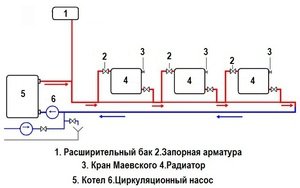
Due to the heating of water in the heating system, according to the laws of physics, it expands in volume. Therefore, to remove its excess in the circuit, an expansion tank is installed. At the same time, in an open heating system, such a structural element is connected to the air in the room through a special pipe. After the coolant cools down, it enters the system again from the expansion tank.
Very often, to increase the efficiency of heating, a single-pipe system is equipped with a circulation pump. which is installed in front of the boiler on the return pipe. Thanks to this addition, the heating rate of a private house, both one-story and two-story, increases significantly, since the coolant begins to circulate according to the forced principle.
To facilitate filling the heating system with water, a cold water supply pipeline is connected at the place where the return pipe passes through the locking mechanism and the cleaning filter. Also, at the lowest point of the system, a drain pipe with a tap at the end is mounted.Such a device allows, if necessary, to drain the entire coolant from the system.
In private housing construction, standard radiators with a lower connection diagram are usually used. In addition, each battery for removing air congestion is equipped with a Mayevsky crane. In addition, in private houses for "Leningrad" they often use a serial diagonal method of connecting batteries.
But, despite the popularity of such heating wiring diagrams, they have a common significant drawback - they do not provide for adjusting the heat transfer level of each individual battery. To solve this problem, there is a radically different way to connect radiators.
To improve the operation of the heating system by adjusting the heat of each radiator, parallel connection of all batteries to the riser is used. At the same time, each heating device is equipped with shut-off valves at the inlet and outlet pipes. Also, in a section of the riser parallel to the battery, which in such a situation acts as a bypass, a needle valve is mounted to adjust the intensity of the water flow through the heating battery. This was achieved thanks to the laws of physics, because when the locking mechanism is fully opened, the coolant will not flow up the battery, overcoming gravity. This leads to the fact that with an increase in the degree of opening of the valve, the temperature in the battery decreases.
Mounting Recommendations
A horizontal single-pipe heating system for a private house will work well with a small number of radiators on one ring branch. Hence the first recommendation: do not plan to put more than five batteries on 1 highway, otherwise the last of them will heat very weakly or remain completely cold. At the same time, try to adhere to the following rules:
- if possible, use not a lower versatile connection of radiators, but a diagonal one, so that the coolant passes through the entire device from top to bottom. This will increase its heat transfer;
- at the inlet to the radiators, install shut-off ball valves, and at the outlet - balancing valves, with whose help the system is adjusted after startup;
- ball valves choose full bore;
- if a solid fuel boiler serves as a heat source, then it is necessary to properly tie it. In addition, it is highly desirable to install a buffer tank.
When it is necessary to provide heat for a small two-story house, the following do-it-yourself Leningrad scheme can be used:
Note. It is not necessary to install valves on a straight line, as shown in the diagram. Put them on the outputs of the batteries, as described above, and you will be able to successfully balance the system.
In small one-story houses, it is still possible to work "Leningradka" without a pump. For those who decide to assemble it, it is still recommended to install the pump on the bypass. After leaving the boiler, it will be necessary to mount a vertical accelerating collector in order to ensure good flow of the coolant into the batteries, as shown in the diagram:
